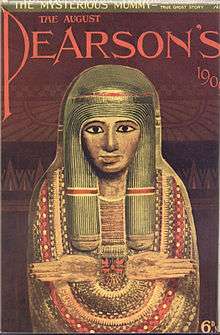Unlucky Mummy
| The Unlucky Mummy | |
|---|---|
 Cover of Pearson's Magazine in 1909 featuring the story of the mummy. | |
| Material | Wood, plaster |
| Size | Length: 162 cm (64 in) |
| Created | 950BC (c.) |
| Period/culture | 21st Dynasty |
| Place | Thebes (?) |
| Present location | Room 62, British Museum, London |
| Identification | 22542 |
| Registration | 1889,0731.1 |
The Unlucky Mummy is an Ancient Egyptian artifact in the collection of the British Museum in London. The identity of the original owner is unknown. This "Painted wooden mummy-board of an unidentified woman" was acquired by the British Museum in 1889.[1]
Overview
The name 'Unlucky Mummy' is misleading as the artifact is not a mummy at all, but rather a gessoed and painted wooden 'mummy-board' or inner coffin lid. It was found at Thebes and can be dated by its shape and the style of its decoration to the late 21st or early 22nd Dynasty (c 950–900 BC). In the British Museum it is known by its serial number EA 22542.[2] The beardless face and the position of the hands with fingers extended show that it was made to cover the mummified body of a woman. Her identity is not known due to the brief hieroglyphic inscriptions containing only short religious phrases, and omitting mention of the name of the deceased. The high quality of the lid indicates that the owner was a person of high rank. It was usual for such ladies to participate in the musical accompaniments to the rituals in the temple of Amen-ra; hence early British Museum publications described the owner of 22542 as a 'priestess of Amen-Ra'. E.A. Wallis Budge, Keeper of Egyptian and Assyrian Antiquities from 1894 to 1924, also suggested that she might have been of royal blood, but this was pure speculation and is not supported by the iconography of the lid.
Physical attributes
The mummy-board is 162 centimetres (64 in) in length and made out of wood and plaster. The detail is painted upon the plaster, and hands protrude from the wooden mummy-board. For its age, the mummy-board is of good quality.
Exhibition history
The mummy-board was donated to the British Museum in July 1889 by Mrs Warwick Hunt of Holland Park, London, on behalf of Mr Arthur F Wheeler. It was displayed in the 'First Egyptian Room' of the Museum from the 1890s and has remained on public view ever since,[3] with the exception of periods during the First and Second World Wars, when it was removed from its case for safety. It has left the Museum on a number of occasions, in 1990, when it formed part of a temporary exhibition held at two venues in Australia and between 4 February to 27 May 2007 along with 271 pieces the 'Unlucky Mummy' was exhibited at Taiwan's National Palace Museum during a press conference.[4] The mummy to which the article belonged is said to have been left in Egypt since it never formed part of the collections of the British Museum. The mummy board is currently displayed in Room 62.
The 'Unlucky Mummy' in folklore
The mummy-board has acquired a reputation for bringing misfortune, and a vast web of mythology has developed around it. It has been credited with causing death, injury and large-scale disasters such as the sinking of the RMS Titanic in 1912,[2][5] thereby earning the nickname 'The Unlucky Mummy'. None of these stories have any basis in fact, but from time to time the strength of the rumours has led to a flood of enquiries on the subject. A disclaimer written by Wallis Budge was published in 1934, and yet since that time the myth has undergone further embellishment.
The 'Unlucky Mummy' has also been linked to the death of the British writer and journalist, Bertram Fletcher Robinson.[6][7] Robinson conducted research into the history of that artefact whilst working as a journalist for the Daily Express newspaper during 1904. He became convinced that the 'Unlucky Mummy' had malevolent powers and died just three years later aged 36 years.[8]
References
- ↑ "Search object details". British Museum. Retrieved 2010-06-11.
- 1 2 Robert Hardman (20 November 2006). "Hi Mummy I'm home!". Daily Mail. Retrieved 2008-10-04.
- ↑ "Mummies At The Museum. Egyptian Gallery Changes". The Times. 28 March 1921. p. 11.
(Lady of the College of Amen-Ra) this is the so-called "unlucky mummy"... It was said by all sorts of people that anyone who interfered with her would meet with calamity, and the late Mr. Stead predicted that if any further attempt was made to move the lady it would probably result in the utter destruction of the whole room... Although she has been moved to another place in the Wall-case none of the dire results so confidently foretold are yet known to have occurred.
- ↑ "Photo from Getty Images". Daylife.com. Archived from the original on April 20, 2010. Retrieved 2010-06-11.
- ↑ "Everything But the Egyptian Sinks". Snopes. 16 January 2007. Retrieved 2008-10-04.
- ↑ "Fletcher Robinson & the 'Mummy' (Part I)". BFRonline.BIZ. 2007. Retrieved 2011-09-15.
- ↑ "Fletcher Robinson & the 'Mummy' (Part II)". BFRonline.BIZ. 2007. Retrieved 2011-09-15.
- ↑ "Priestess, dead centuries ago, still potent to slay and afflict" (PDF). The Atlanta Constitution. 19 June 1904.
External links
- This article is about an item held in the British Museum. The object reference is 22542 / Registration:1889,0731.1.